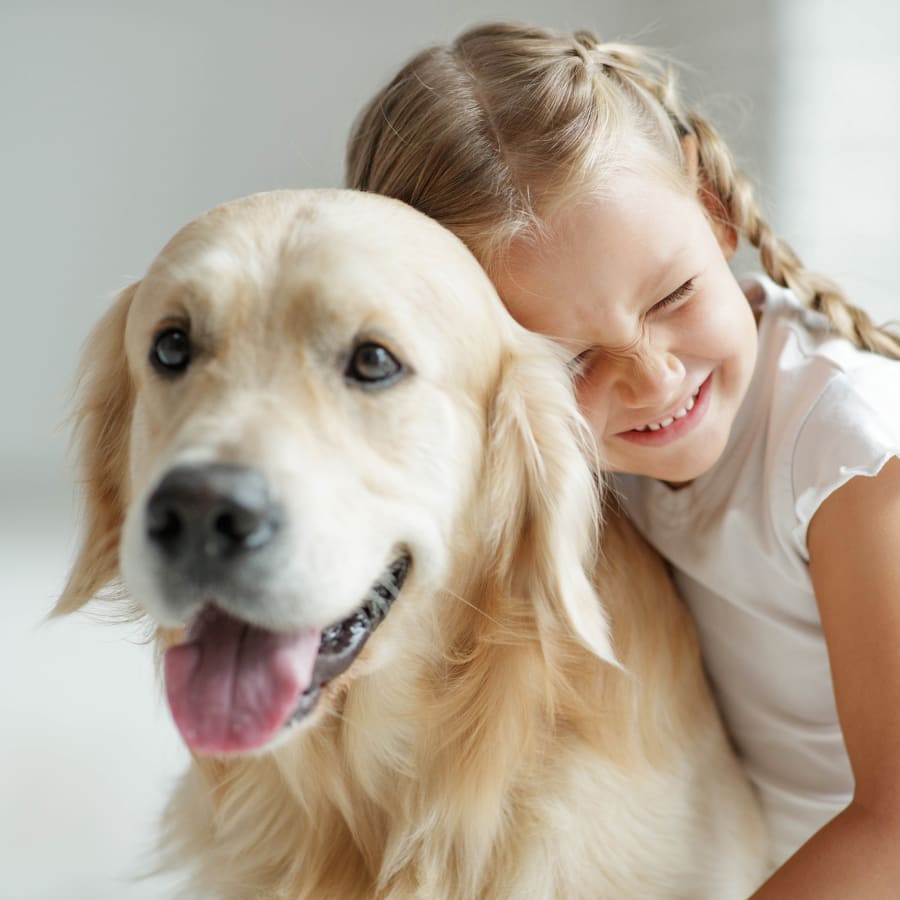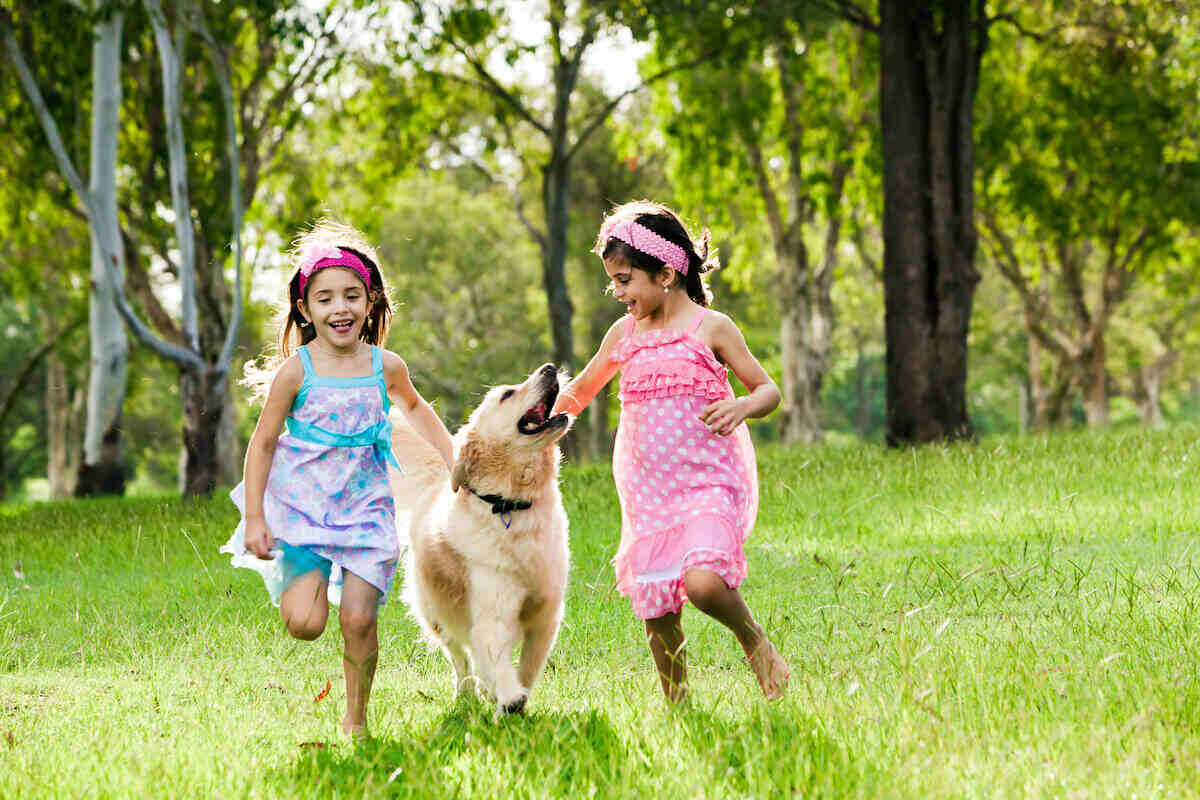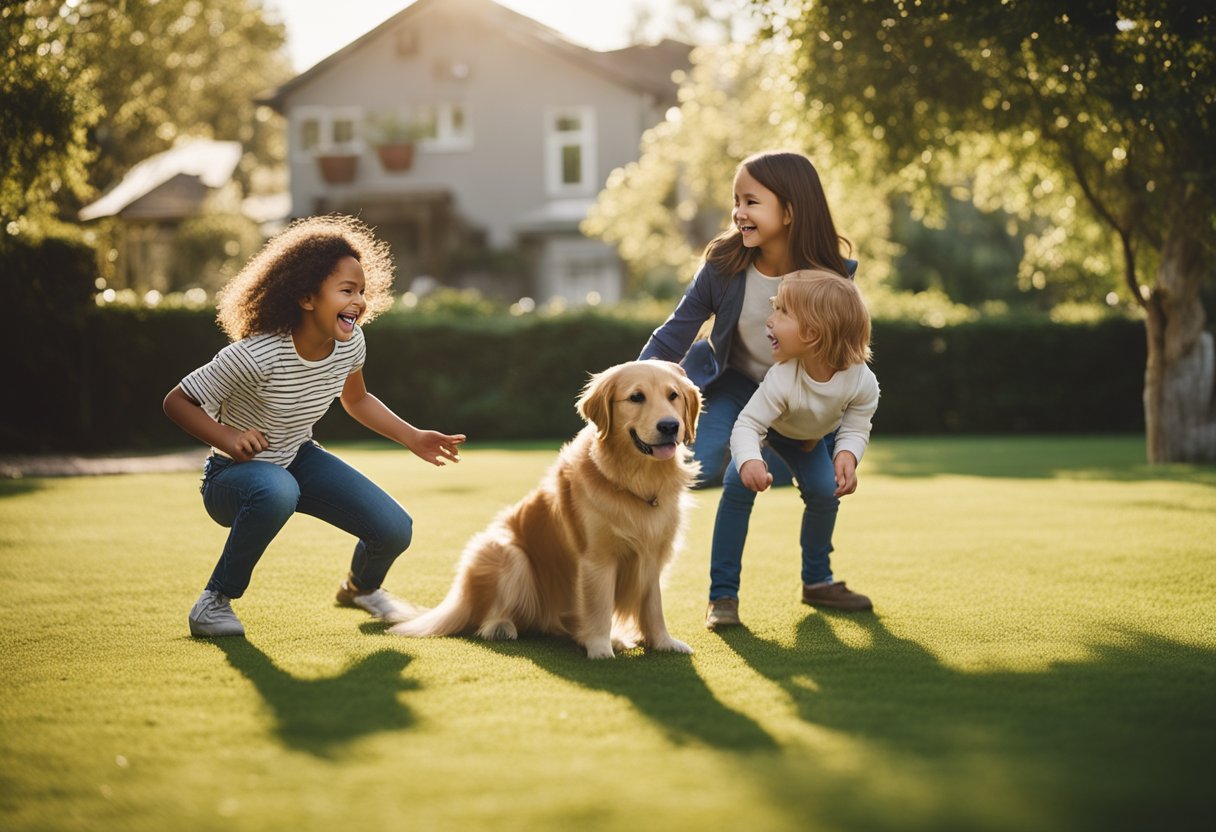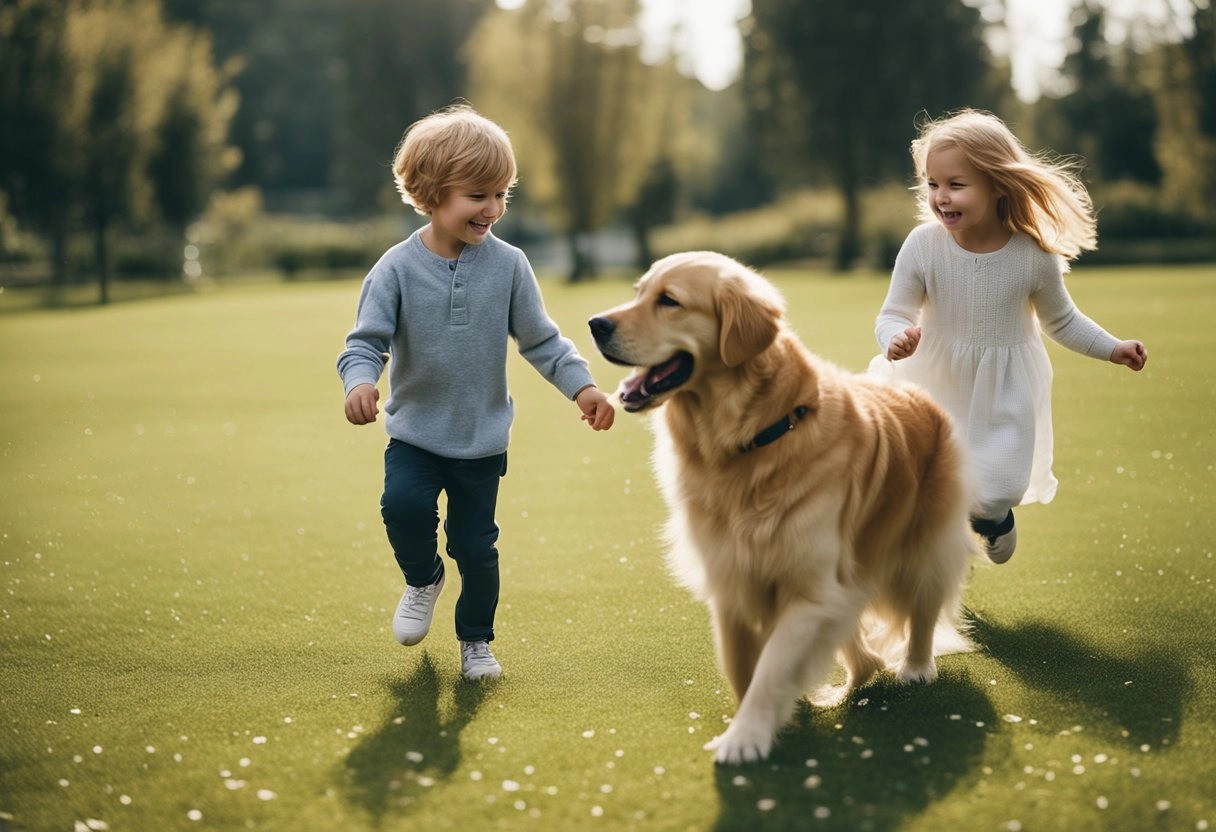As a parent, you will eventually face a tough choice of choosing a family pet. While there are so many dog breeds to choose from, many families came to us finding themselves drawn to the cheerful, affectionate Golden Retrievers.
Of course, we are not surprised. I mean, who doesn’t love their signature bright coat, wagging tails, and seemingly permanent smile? Beyond their adorable appearance, though, parents still want to know if these pups are truly suitable for life with their children. So, are Golden Retrievers good with kids? Let’s find out with us!
Are Golden Retrievers Good with Kids?

The short answer is a resounding yes! Golden Retrievers consistently ranks among the top family-friendly dog breeds according to veterinarians, trainers, and pet behavior experts. Let’s explore the key characteristics that make these furry companions such excellent matches for families with children.
Patient and Loving Disposition
Golden Retrievers are renowned for their exceptional patience, a trait that proves invaluable when interacting with children. These dogs possess an innate ability to remain calm even in the most chaotic situations – a common occurrence in households with young kids. Their breeding history as hunting companions required them to wait quietly for long periods, and this patience has translated beautifully into family life.
Their loving nature also sets them apart. Golden Retrievers form deep emotional bonds with family members of all ages, showing remarkable devotion and gentleness, especially toward children. This natural inclination to nurture makes them particularly well-suited for families with kids of different age groups.
Remarkable Intelligence and Trainability
One of the standout qualities of Golden Retrievers is their high intelligence combined with an eager-to-please attitude. This combination makes them highly receptitious to training, especially when it comes to learning appropriate behavior around children. They quickly understand how to be gentle with toddlers and adjust their energy levels accordingly. These intelligent dogs can masterfully adapt their play style when interacting with older kids. They readily grasp basic commands that ensure safe interactions, making them reliable family companions. Their ability to distinguish between indoor and outdoor appropriate behaviors makes them especially valuable in family settings.
Social Nature and Play Style
Golden Retrievers possess an incredible social intelligence that allows them to adjust their play style based on their companion’s age and size. With toddlers, they often display remarkable gentleness, while they can engage in more vigorous play with older children. This adaptability makes them perfect playmates for growing families.
Their natural retrieval instincts make them excellent partners for interactive games that benefit children’s development. Fetch games encourage outdoor activity and physical exercise, while hide-and-seek activities promote problem-solving skills and cognitive development. Gentle tug-of-war sessions teach children about cooperation and boundaries. Training exercises build a sense of responsibility and achievement in children while strengthening the bond between them and their furry companions.
Read more >> Are Golden Retrievers Good Guard Dogs?
Essential Steps for Introducing Your Golden Retriever to Children

A successful relationship between your Golden Retriever and children requires careful planning and proper introduction. Here’s a comprehensive guide to ensuring a smooth transition:
Step 1: Child Preparation
The key to a successful introduction begins long before your Golden Retriever comes home. Start by having an open conversation with your children about what it means to have a dog in the family. Help them understand how dogs communicate through body language, including tail positions, ear movements, and facial expressions. This knowledge will help your children recognize when their new friend is happy, nervous, or needs space.
Once they grasp these basics, work together to establish family rules for interacting with the dog. Use role-playing exercises with stuffed animals to demonstrate gentle petting techniques and appropriate ways to approach a dog. This hands-on practice helps children develop muscle memory for gentle touches and calm movements. Make it clear that just like humans, dogs sometimes need quiet time alone, and respecting the dog’s personal space is crucial for building trust. Finally, involve children in planning how they’ll help care for their new pet, whether it’s filling water bowls or helping with grooming, as this creates excitement while teaching responsibility.
Step 2: Setting Up a Dog-Friendly Environment
Creating the right environment is essential for fostering positive relationships between your children and new pet. Begin by designating a peaceful retreat area where your Golden Retriever can rest undisturbed when feeling overwhelmed. This space should feel like a safe haven, perhaps in a quiet corner of your home or under a desk.
Consider your home’s layout when arranging feeding areas, keeping them away from busy spots where children frequently play or run. This thoughtful placement helps prevent food-related anxiety and allows your dog to eat peacefully. Organization plays a crucial role too – establish separate areas for storing Golden Retriever’s dog toys and children’s playthings to avoid confusion and potential resource guarding. If you have a multi-level home or want to create distinct spaces, strategically placed baby gates can help manage movement and interactions, especially during the adjustment period.
Finally, work with your family to identify and set up designated play zones where children and the dog can interact safely under supervision.
Step 3: Managing the Introduction Process
The initial meeting between your children and Golden Retriever sets the foundation for their entire relationship. Choose a spacious, neutral area for the first introduction – perhaps a fenced backyard or a quiet room – where both the dog and children have freedom to move comfortably. Keep this first meeting positive but brief to prevent overwhelming either party.
Let your Golden Retriever take the lead in approaching the children, as this builds confidence and trust naturally. When your dog shows interest in gentle investigation, praise this behavior with some of the Golden Retriever dog food. Similarly, reward your children’s calm demeanor with positive reinforcement. Throughout the introduction, maintain a cheerful, relaxed atmosphere – your energy will influence both the children’s and dog’s behavior. Remember that this initial meeting is just the beginning of their relationship, and there’s no need to rush the bonding process.
Step 4: Establishing Daily Routines

Structure and consistency form the backbone of successful integration between your Golden Retriever and children. Start by creating a clear daily schedule that includes regular feeding times, walks, and dedicated play sessions. This predictability helps your dog feel secure and allows children to understand when they can expect interaction time with their new friend.
Involve your children in age-appropriate pet care tasks that match their abilities and maturity levels. Younger children might help with simple tasks like filling water bowls, while older ones can assist with feeding or join you on dog walks. Set aside specific times each day for supervised interactions, gradually increasing duration as everyone becomes more comfortable with each other. Remember to maintain consistent rules and boundaries – if the dog isn’t allowed on furniture today, the same should apply tomorrow.
Common Questions About Golden Retrievers and Kids
At What Age Should We Introduce a Golden Retriever?
While Golden Retrievers can adapt to families with children of any age, many experts recommend waiting until children are at least 4-5 years old. This age ensuresa better understanding of gentle handling and following safety rules. However, with proper supervision, Golden Retrievers can safely interact with younger children as well.
How Do I Manage the Energy Level of a Golden Retriever Around Kids?
Managing your Golden Retriever’s energy levels requires a comprehensive approach. Regular exercise routines help burn excess energy and maintain a calm demeanor. Structured play sessions provide mental stimulation while teaching appropriate behavior. Mental stimulation activities keep your dog engaged and focused. Consistent training reinforces good habits and maintains boundaries. Adequate rest periods ensure your dog stays balanced and relaxed throughout the day.
What Makes Golden Retrievers Different from Other Family Dogs?
Golden Retrievers stand out due to their exceptional patience levels, which surpass many other breeds. Their natural gentleness with small children creates safe and enjoyable interactions. High trainability makes them easier to integrate into family life. Their strong desire to please family members results in devoted and attentive companions. Their adaptable play style allows them to interact appropriately with children of all ages.
Should I Choose a Male or Female Golden Retriever?
Both genders make excellent family pets. The choice often depends on individual personality traits, which vary regardless of gender. Size preferences may influence your decision, as males tend to be larger. Energy levels can vary individually and should be evaluated on a case-by-case basis. Training history plays a crucial role in determining suitability for your family. Personal preference may ultimately guide your choice, as both males and females can excel as family companions.
Final Thoughts
Golden Retrievers truly excel as family dogs, particularly in households with children. Their combination of patience, intelligence, and gentle nature makes them ideal companions for families of all sizes. However, success depends on proper preparation, consistent training, and ongoing supervision of interactions between children and dogs.
With the right approach, a Golden Retriever can become not just a pet, but a beloved family member who helps create lasting memories and teaches children valuable lessons about responsibility, empathy, and unconditional love.

As a professional writer who specializes in canine care, I have spent a significant amount of time researching and writing about Golden Retrievers. While I do not own a Golden Retriever, my considerable research and collaboration with doctors, breeders, and Golden Retriever experts has provided me with a lot of information about this incredible breed. My writing covers a wide range of topics, from food and health concerns to behavior and training, to assist owners in raising well-rounded, healthy golden retrievers. Through this website, I wish to share my knowledge and positively touch the lives of both dogs and their humans.

